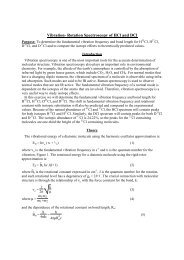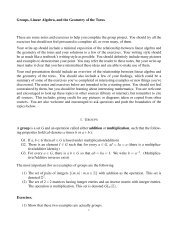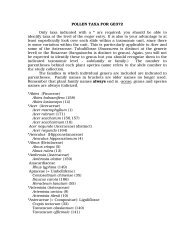Analysis of a Chemical Mixture Using the Ideal Gas Law
Analysis of a Chemical Mixture Using the Ideal Gas Law
Analysis of a Chemical Mixture Using the Ideal Gas Law
You also want an ePaper? Increase the reach of your titles
YUMPU automatically turns print PDFs into web optimized ePapers that Google loves.
PRELAB:<br />
Reading:<br />
<strong>Analysis</strong> <strong>of</strong> a <strong>Chemical</strong> <strong>Mixture</strong> <strong>Using</strong> <strong>the</strong> <strong>Ideal</strong> <strong>Gas</strong> <strong>Law</strong><br />
1. Sections 10.4 & 10.6 <strong>of</strong> Brown, LeMay, Bursten, and Murphy.<br />
2. This handout.<br />
Questions:<br />
Silver oxide can be decomposed to yield silver metal and oxygen gas according to <strong>the</strong> equation below. You conduct<br />
this reaction with an unknown mass <strong>of</strong> Ag2O, and collect 81.2 mL <strong>of</strong> O2 over water. If <strong>the</strong> ambient temperature is<br />
23 °C and <strong>the</strong> pressure is 751 mmHg, what mass <strong>of</strong> Ag2O did you start with? (The vapor pressure <strong>of</strong> water at 23 °C<br />
is 21.1 mmHg.)<br />
INTRODUCTION:<br />
2 Ag2O(s) → 4 Ag (s) + O2 (g)<br />
The evolution <strong>of</strong> gas as part <strong>of</strong> a chemical reaction can be a useful feature in determining <strong>the</strong> identity, quantity, or<br />
purity <strong>of</strong> chemical compounds. For instance, given a mixture <strong>of</strong> two somewhat similar compounds in which only<br />
one will react and evolve gas in <strong>the</strong> presence <strong>of</strong> ano<strong>the</strong>r specific reagent, <strong>the</strong> mass percentage <strong>of</strong> <strong>the</strong> compounds can<br />
be discerned by measuring <strong>the</strong> quantity <strong>of</strong> gas evolved in <strong>the</strong> reaction.<br />
In this lab you will be given a mixture <strong>of</strong> sodium chloride (NaCl) and sodium nitrite (NaNO2) – <strong>the</strong> composition <strong>of</strong><br />
this mixture will be ‘unknown’. You will quantitatively measure <strong>the</strong> amount <strong>of</strong> product formed by <strong>the</strong> reaction <strong>of</strong><br />
one <strong>of</strong> <strong>the</strong> components under conditions where <strong>the</strong> o<strong>the</strong>r component is inert and does not react. One <strong>of</strong> <strong>the</strong> products<br />
<strong>of</strong> <strong>the</strong> reaction is a gas, which can be collected and its volume can be determined under measured conditions <strong>of</strong><br />
pressure and temperature. The number <strong>of</strong> moles <strong>of</strong> gaseous product can be calculated using <strong>the</strong> <strong>Ideal</strong> <strong>Gas</strong> <strong>Law</strong>. The<br />
moles <strong>of</strong> product can be related to <strong>the</strong> moles and mass <strong>of</strong> <strong>the</strong> reactant from which <strong>the</strong> product was formed. By<br />
knowing <strong>the</strong> mass <strong>of</strong> <strong>the</strong> one component that reacted, <strong>the</strong> mass <strong>of</strong> <strong>the</strong> o<strong>the</strong>r component can <strong>the</strong>n be determined by<br />
difference from <strong>the</strong> total mass <strong>of</strong> <strong>the</strong> chemical mixture tested. Finally, percent composition by mass can be<br />
calculated<br />
Each group will react <strong>the</strong> same sample three times, each time with an excess <strong>of</strong> sulfamic acid, HSO3NH2. The<br />
NaCl is unreactive under <strong>the</strong>se conditions, whereas <strong>the</strong> NaNO2 reacts to form nitrogen gas according to <strong>the</strong> reaction<br />
equation given below. The N2 gas will be collected at atmospheric pressure and room temperature. Each group will<br />
calculate <strong>the</strong> moles <strong>of</strong> N2, <strong>the</strong> moles <strong>of</strong> NaNO2, <strong>the</strong> mass <strong>of</strong> NaNO2, <strong>the</strong> mass <strong>of</strong> NaCl, and <strong>the</strong> percent composition<br />
by mass <strong>of</strong> NaNO2 and NaCl in <strong>the</strong> mixture.<br />
NO -<br />
2 (aq) + HSO3NH2(aq) −−> HSO -<br />
4 (aq) + H2O(l) + N2(g)
PROCEDURE 1 : (REFER TO FIGURE 1.)<br />
-2- CH 141 Lab: <strong>Gas</strong> <strong>Law</strong>s<br />
Working with a partner you will use an apparatus similar to that shown in Figure 1. Weigh ~0.18 g <strong>of</strong> sulfamic acid,<br />
HSO3NH2, remove stopper A, and add <strong>the</strong> sulfamic acid to <strong>the</strong> given 50-mL Erlenmeyer flask. Add 10. mL <strong>of</strong><br />
distilled water. CAUTION: Sulfamic acid and sodium nitrite must never be mixed toge<strong>the</strong>r as solids. In <strong>the</strong><br />
presence <strong>of</strong> traces <strong>of</strong> water <strong>the</strong> solids react to evolve nitrogen and heat so rapidly as to be dangerous.<br />
Weigh just over 0.1 g <strong>of</strong> <strong>the</strong> chemical mixture from your group’s sample into a dry 1-dram vial. Add 1 mL<br />
<strong>of</strong> distilled water to <strong>the</strong> vial, and lower <strong>the</strong> vial carefully into <strong>the</strong> Erlenmeyer flask. It should rest against <strong>the</strong> bottom<br />
and side <strong>of</strong> <strong>the</strong> Erlenmeyer flask without allowing any solution to ei<strong>the</strong>r enter or leave <strong>the</strong> vial.<br />
A<br />
Figure 1. Apparatus for reaction <strong>of</strong> a mixture.<br />
Sufficient water has been added to <strong>the</strong> leveling bulb. By raising <strong>the</strong> bulb appropriately, you should be able to fill <strong>the</strong><br />
measuring tube to within 1 mL <strong>of</strong> <strong>the</strong> upper calibration mark (at 50.00mL) when <strong>the</strong> water level in <strong>the</strong> bulb is <strong>the</strong><br />
same as in <strong>the</strong> measuring tube. Check <strong>the</strong> apparatus for leaks by inserting stopper A securely and lowering and<br />
raising <strong>the</strong> leveling bulb. If all <strong>the</strong> joints are tight, <strong>the</strong> level <strong>of</strong> <strong>the</strong> water in <strong>the</strong> measuring tube will return to its<br />
original level when <strong>the</strong> leveling bulb is raised to its starting position.<br />
Then insert stopper A securely into <strong>the</strong> Erlenmeyer flask. CAUTION: Be sure that <strong>the</strong> rubber tubing connecting<br />
<strong>the</strong> Erlenmeyer flask and <strong>the</strong> measuring tube is free <strong>of</strong> kinks. Before starting <strong>the</strong> reaction have your instructor<br />
check your apparatus. Now adjust <strong>the</strong> leveling bulb so that <strong>the</strong> water levels in <strong>the</strong> leveling bulb and <strong>the</strong> measuring<br />
tube are exactly <strong>the</strong> same. Read <strong>the</strong> initial volume indicated by <strong>the</strong> bottom <strong>of</strong> <strong>the</strong> meniscus in <strong>the</strong> measuring<br />
tube(aligned to <strong>the</strong> meniscus in <strong>the</strong> leveling bulb) and record <strong>the</strong> initial volume in your lab notebook to <strong>the</strong> nearest<br />
hundredths place. Notice how <strong>the</strong> graduations on <strong>the</strong> measuring tube are oriented; you need to consistently read <strong>the</strong><br />
values from <strong>the</strong>se graduations.<br />
1 Adapted from Chemistry in <strong>the</strong> Laboratory by C.W.J. Scaife and O.T. Beachley, Jr., Saunders, 1987.<br />
B
-3- CH 141 Lab: <strong>Gas</strong> <strong>Law</strong>s<br />
Tip <strong>the</strong> 50-mL Erlenmeyer flask so that some mixing <strong>of</strong> <strong>the</strong> sulfamic acid solution with <strong>the</strong> solution inside <strong>the</strong> vial<br />
occurs. <strong>Gas</strong> evolution should begin. Over <strong>the</strong> course <strong>of</strong> <strong>the</strong> reaction, periodically lower <strong>the</strong> leveling bulb so that <strong>the</strong><br />
water levels in <strong>the</strong> leveling bulb and measuring tube are approximately <strong>the</strong> same. This reduces <strong>the</strong> gas pressure in<br />
<strong>the</strong> system and helps prevent leaks. DO NOT allow <strong>the</strong> water level to go above <strong>the</strong> 50.00mL level in <strong>the</strong> measuring<br />
tube (see Figure 1). As gas evolution decreases, tip <strong>the</strong> Erlenmeyer flask more to achieve additional mixing.<br />
Continue to mix <strong>the</strong> solutions by gentle rocking <strong>of</strong> <strong>the</strong> flask until <strong>the</strong>re is no fur<strong>the</strong>r evolution <strong>of</strong> nitrogen gas. While<br />
waiting, ~ 5 minutes to allow <strong>the</strong> contents <strong>of</strong> <strong>the</strong> flask to return to room temperature, record <strong>the</strong> room temperature. A<br />
<strong>the</strong>rmometer will be located at <strong>the</strong> front <strong>of</strong> <strong>the</strong> lab. Reference <strong>the</strong> chart provided in lab to determine <strong>the</strong> vapor<br />
pressure (partial pressure) <strong>of</strong> water, using your room temperature value. Record <strong>the</strong> barometric pressure that is<br />
posted in lab.<br />
Adjust <strong>the</strong> leveling bulb so that <strong>the</strong> water levels in <strong>the</strong> leveling bulb and <strong>the</strong> measuring tube are again exactly <strong>the</strong><br />
same. At this point, <strong>the</strong> pressure <strong>of</strong> <strong>the</strong> gas is equal to atmospheric pressure. Read <strong>the</strong> final volume <strong>of</strong> gas in <strong>the</strong><br />
measuring tube, and record it in your lab notebook. Clean <strong>the</strong> Erlenmeyer flask, and repeat <strong>the</strong> experiment using <strong>the</strong><br />
same sample and a dry dram vial each time, until three successful trials have been completed.<br />
Your experimental data needs to be entered into a grading spreadsheet before<br />
you leave lab today. Your work will be assessed on <strong>the</strong> precision & accuracy (you don’t need to calculate<br />
accuracy yourself as you don’t know <strong>the</strong> actual mass percentage) <strong>of</strong> your chemical mixture composition<br />
determination based on <strong>the</strong> information you provide to this spreadsheet.<br />
What should be in your laboratory notebook?<br />
1. Record all masses, temperatures, volumes, calculations, observations, etc.<br />
2. Calculate <strong>the</strong> average mass percentage, <strong>the</strong> standard deviation, <strong>the</strong> % relative standard deviation,<br />
and <strong>the</strong> % precision for <strong>the</strong> %NaNO2 in your unknown mixture sample using data from all three trials.<br />
What should be attached to your discussion now but put into your laboratory notebook<br />
later?<br />
The Supplemental Report Sheet.<br />
What should be in your discussion?<br />
Address your objective, report your results (including precision) and <strong>the</strong> significance <strong>of</strong> each. Be sure to use proper<br />
significant figures in your discussion. Identify and discuss <strong>the</strong> two most significant sources <strong>of</strong> random experimental<br />
error relative to your reported results. Additionally, address whe<strong>the</strong>r <strong>the</strong> % NaNO2 would have been larger than,<br />
smaller than, or no different from your calculated value if (A) <strong>the</strong> partial pressure <strong>of</strong> water was ignored in <strong>the</strong><br />
calculations, and (B) <strong>the</strong> amount <strong>of</strong> sulfamic acid added to <strong>the</strong> reaction was doubled.
Supplemental report sheet<br />
-4- CH 141 Lab: <strong>Gas</strong> <strong>Law</strong>s<br />
Parameter Trial #1 Trial # 2 Trial # 3<br />
unknown mixture #<br />
unknown mixture, g<br />
sulfamic acid, g<br />
starting volume, mL<br />
ending volume, mL<br />
Volume <strong>of</strong> N2<br />
gas collected , mL<br />
Volume <strong>of</strong> N2<br />
gas collected , L<br />
Barometric pressure, mmHg<br />
Barometric pressure, atm<br />
Room temp, 0 C<br />
Room temp, K<br />
Vapor pressure H2O, atm<br />
Pressure N2 gas, atm<br />
Moles N2 collected<br />
Moles NaNO2<br />
NaNO2 reacted, g<br />
Mass% NaNO2<br />
in unknown mixture<br />
NaCl in unknown, g<br />
Mass% NaCl in unknown<br />
mixture<br />
average % mass NaNO2= ____________________<br />
standard deviation= ____________________<br />
% relative standard deviation=___________________<br />
% precision= __________________<br />
“same unknown<br />
number”<br />
“same unknown<br />
number”
















